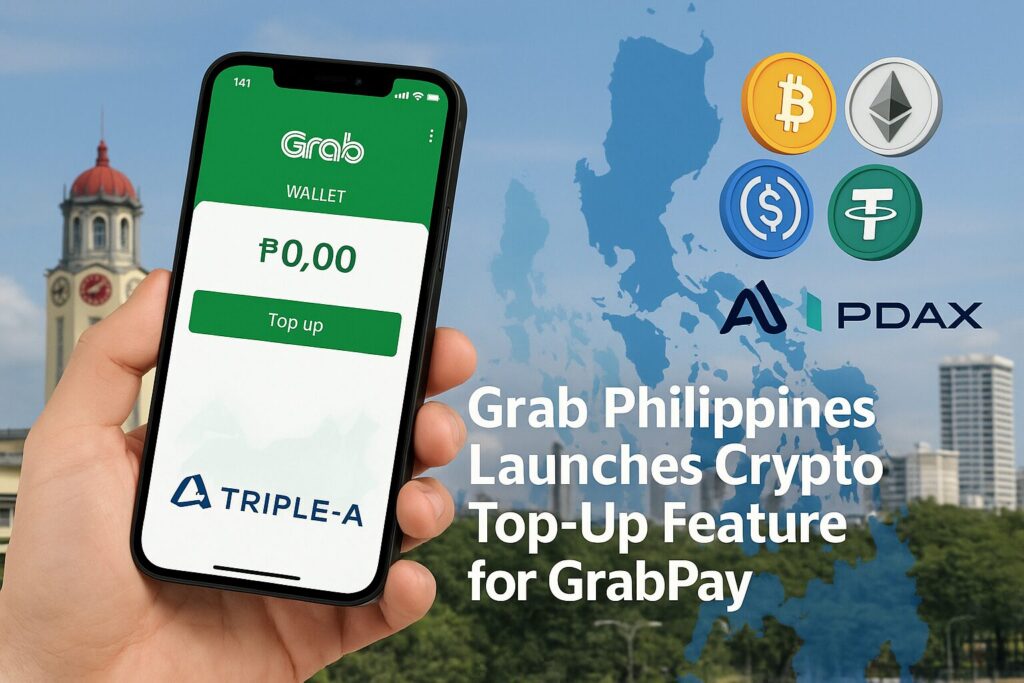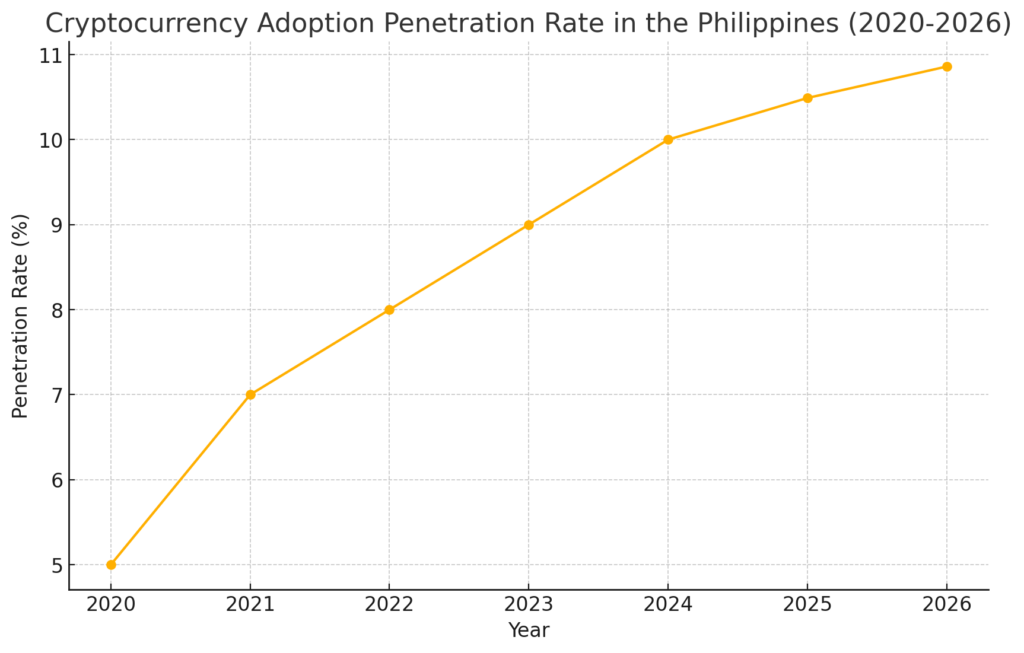
Main Points:
- Grab Philippines enables users to top up GrabPay wallets using Bitcoin (BTC), Ethereum (ETH), USDC, and USDT via Triple‑A and PDAX partnerships.
- The move taps into the Philippines’ high crypto adoption rate—currently around 10%—and fosters financial inclusion for the unbanked.
- Regulatory support from Bangko Sentral ng Pilipinas (BSP), U.S. FinCEN, and Singapore’s MAS ensures a compliant, secure framework.
- Grab aims to broaden use cases across ride‑hailing, delivery, mobile top‑up, and beyond, positioning itself within a larger Web3 and DeFi strategy.
- The Philippines is ranked 8th globally in crypto adoption, with forecasts projecting 12.79 million adopters by 2026 .
1. Expanding Crypto Payments with GrabPay
Grab Philippines, Southeast Asia’s leading ride‑hailing and digital services platform, officially rolled out a crypto top‑up feature for its GrabPay wallet on July 28, 2025. Filipino users can now convert Bitcoin (BTC), Ethereum (ETH), USD Coin (USDC), or Tether (USDT) into Philippine pesos and instantly credit their GrabPay account through a simple in‑app workflow. After selecting “Cryptocurrencies” in the Grab app, users specify amount, token, and network; a designated wallet address then appears to finalize the transfer. Funds reflect immediately, ready to be spent on rides, food delivery, mobile load, and other Grab services.
This functionality follows Grab’s successful Singapore rollout in 2024, signaling the company’s commitment to merging decentralized finance (DeFi) solutions with everyday consumer experiences. By eliminating reliance on traditional bank accounts, the feature opens the door for crypto holders—both seasoned and new entrants—to leverage their digital assets directly for daily transactions.
2. Partnerships and Regulatory Compliance
The service operates through strategic alliances with Triple‑A, a crypto payments firm regulated by the Monetary Authority of Singapore (MAS) and U.S. FinCEN, and PDAX, a Bangko Sentral ng Pilipinas–licensed exchange. Triple‑A CEO Eric Barbier highlights strong Singapore adoption as a proof point, noting that the Philippine market shares similar digital‑currency receptiveness. PDAX CEO Nichel Gaba adds that the feature not only serves crypto‑savvy users but also attracts newcomers by simplifying access to digital‑asset utility.
Behind the scenes, the Bangko Sentral ng Pilipinas introduced its crypto regulatory framework in 2017, instituting mandatory registration and licensing for virtual asset service providers. This robust yet crypto‑friendly policy environment has provided Grab and its partners the green light to pursue financial‑inclusion initiatives while adhering to stringent compliance standards.
3. Driving Financial Inclusion in the Philippines
Roughly 70 million adult Filipinos remain underbanked or unbanked, yet smartphone penetration exceeds 80% nationwide. Crypto top‑ups for GrabPay thus address a critical gap: digital‑first payment methods that bypass traditional banking hurdles. Grab Philippines executive CJ Lacsican emphasizes, “Our goal is to empower more Filipinos with digital payment tools, independent of conventional banks.”
The impact extends to remittance corridors as well. Overseas Filipino Workers (OFWs), who collectively remit over $36 billion annually, can convert digital assets sent home into locally usable credits on the Grab platform, reducing friction and fees typically associated with remittance services.
4. Broader Market Trends and Future Outlook
The Philippines ranks 8th globally in crypto adoption, with about 10% of the population using digital assets and projections estimating 12.79 million users by 2026. Adoption climbed from 5% in 2020 to over 10% in 2024, demonstrating steady growth amid a crypto‑favorable regulatory climate.
[Insert Figure 1 here: Cryptocurrency Adoption Penetration Rate in the Philippines (2020–2026)]

Grab’s initiative dovetails with broader Southeast Asian momentum: region‑wide, ride‑hailing and e‑commerce firms are exploring crypto payments, and stablecoin usage is rising in cross‑border transactions. Moreover, major financial institutions and digital banks are piloting blockchain‑based solutions for trade finance, insurance underwriting, and digital identity verification across the region.
Looking ahead, Grab plans to expand crypto top‑ups to additional markets where GrabPay operates and to integrate DeFi features such as on‑ramp/off‑ramp services, tokenized rewards, and smart‑contract–based merchant settlements. This evolution will likely cement Grab’s role as a bridge between Web2 convenience and Web3 innovation.
5. Integration with Grab’s Ecosystem
Currently, crypto‑funded balances support ride‑hailing, food delivery, and mobile load purchases. Grab is testing pilot programs to extend usage to grocery orders, bill payments, and even peer‑to‑peer transfers within the app. By layering crypto on top of its existing loyalty program, Grab can incentivize token holders with boosted rewards and exclusive promotions, further driving platform engagement.
Additionally, Grab’s developer ecosystem may soon offer APIs for third‑party merchants to accept GrabPay credits funded by crypto, opening a new channel for SMEs to tap into digital‑asset liquidity without building in‑house crypto infrastructure.
Conclusion
Grab Philippines’ launch of a crypto top‑up feature for GrabPay lipsticks a watershed moment in bridging decentralized finance and mass‑market digital payments. Leveraging partnerships with Triple‑A and PDAX under a clear BSP regulatory framework, Grab has crafted a secure, compliant mechanism for converting BTC, ETH, USDC, and USDT into spendable pesos. This move accelerates financial inclusion for underbanked populations, enhances remittance efficiency for OFWs, and positions Grab at the forefront of Web3 integration in Southeast Asia.
As the Philippines’ crypto adoption surpasses 10% and continues to climb, Grab’s innovation aligns with consumer demand for fast, flexible, and border‑neutral payment solutions. The ripple effects extend well beyond ride‑hailing, setting the stage for a new era of digital commerce where crypto and fiat coalesce seamlessly. For readers hunting the next profitable crypto asset or exploring real‑world blockchain applications, Grab’s crypto top‑up feature exemplifies practical DeFi utility unlockable within everyday apps.

